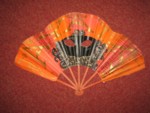[click on images for bigger view]
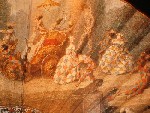
fig.6 Detail
of a Commedia dell'Arte fan, mid-18th century, photography taken from
E.Taylor/A.Hart's book "Fans"
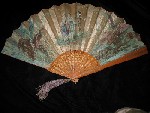
fig.8 Satin
fan with a chromolithography depicting Columbina followed by Pierrot
and Arlecchino, approx. 1880, in a box labeled in Cyrillic "Alexandre,
Saint Petersburg"

Pastiche mask fan by Duvelleroy, photo courtesy
Serge Davoudian.
Commedia dell'Arte and Fans cont'd
Commedia
scenes influenced the baroque and rococo lifestyle where grandiose balls
took the disguise of Venetian-style masquerades. And there we meet a
second implement that is closely related to the fan: the mask.
The Zanni of the Commedia dell'Arte all wore masks as part of their
typical dress. Masks are part of archaic rituals, and one of the legends
of the emergence of the fan tells us that Lam-Si, the beautiful daughter
of a Chinese mandarin, suffered from the heat at a banquet, and lifted
her mask and fanned herself with it. The fan was born!
Masks and fans often serve similar purposes as one can hide oneself
behind, spy on someone without being seen, or simply act more liberally
in disguise! In the second half of the 18th century, Venetian gentleman
and - women wore masks, not only during carnaval, but also when going
to the theatre or banquets. Men usually wore the "bauta",
a white upper mask that went along with a large black cape and a tricorne.
Women held a "moretta" mask in front of their faces (an oval
full-face mask, either handheld with a stick, or teeth-held with a button!).
Sometimes women substituted a scarf or a fan for the mask.
The most famous mask fan is the early 18the century fan quoted and depicted so often in literature, in printed and painted versions. But the fan leaves of the mid-18th century also show court balls in masks, with persons disguised as characters of the Commedia dell'Arte. One example is the detail of such a fan, fig. 6. It is shown in Avril Hart and Emma Taylors book on fans (Biblio No. 2). These fans are nowadays rare, in 2000 a similar fan was sold at Christies for more than 16000 EURO!
The topic of the Commedia dell'Arte re-emerges again in the mid-19th century with its love for 18th century topics. Although some commedia costumes date from the beginning of the 19th century, the performances were declining. It must be noted, however, that its influence on German and Austrian popular scene plays and characters of the 19th century was considerable. The well-known "Hanswurst" features similar dresses as well as the slapstick ("Holzpritsche" in old fashioned German). Two rare fans of this topic are in the collection of the Carolino Augusteum Museum in Salzburg (see fig. 7, with Hanswurst performing an atypical household chore). It is interesting to note that Hanswurst also wears a half-mask, but on the LOWER part of his face! (It is not a beard as one might think!).
Masked balls during carnival time (in Vienna called "Redouten" from the Italian "ridotto") were customary in Austria, but also in France during the 19th century. The more exquisite fans produced for this occasion were re-makes of 18th century fans. The simpler versions printed them on silk (fig. 8). During the Belle Epoque and the beginning of the 20th century, Commedia dell'Arte characters are transformed into small Pierrots that look more like naughty Putti (fig. 9). The topics of apple-stealing pierrots appear also in fan literature such as S. Mayor (Biblio No. 25).
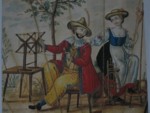
fig.7 Hanswurst
fan of the Carolino Augusteum Museum in Salzburg, approx. 1720/30; photography
taken from brochure.
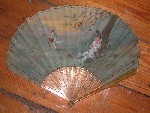
fig.9 Apple-stealing
pierrots with a sleeping Napoleon-Pierrot, approx. 1900, French?
